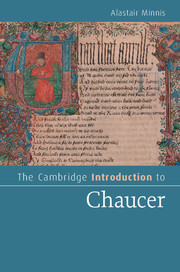Book contents
- Frontmatter
- Contents
- List of illustrations
- List of abbreviations
- Introduction Life and historical contexts
- Chapter 1 Love and lore: the shorter poems
- Chapter 2 Fictions of antiquity: Troilus and Criseyde and The Legend of Good Women
- Chapter 3 The Canterbury Tales, I: war, love, laughter
- Chapter 4 The Canterbury Tales, II: experience and authority
- Afterword
- Notes
- Further reading
- Index
Chapter 3 - The Canterbury Tales, I: war, love, laughter
Published online by Cambridge University Press: 05 October 2014
- Frontmatter
- Contents
- List of illustrations
- List of abbreviations
- Introduction Life and historical contexts
- Chapter 1 Love and lore: the shorter poems
- Chapter 2 Fictions of antiquity: Troilus and Criseyde and The Legend of Good Women
- Chapter 3 The Canterbury Tales, I: war, love, laughter
- Chapter 4 The Canterbury Tales, II: experience and authority
- Afterword
- Notes
- Further reading
- Index
Summary
The Canterbury Tales comprises a rich array of subjects and styles. Roman antique, fabliau, conversion narrative, matrimonial satire, ecclesiastical critique, romance (in several forms), Breton lay, saint’s life, Mariological miracle, tragedy, beast fable, and penitential treatise are all represented, but it should be emphasized that many of Chaucer’s narratives resist neat classification – not least because of the broad social spectrum reflected by the tellers to which they are assigned. Rhyming couplets are the staple verse form, although in the tales told by the Man of Law, Clerk, Prioress and Second Nun, rhyme royal is deployed, to which must be added the unique Monk’s Tale stanza (of eight five-stress lines rhyming ababbcbc), the demotic loose rhymes and rhythms of Sir Thopas and the accomplished didactic prose of the Melibee and The Parson’s Tale.
If an all-encompassing genre is sought for The Canterbury Tales, then we can come up with no better than ‘medieval satire’. By this I mean certain classical notions of satire as understood and interpreted in the later Middle Ages, encompassing what usually is called either satira communis or ‘estates satire’. In Medieval Latin, the term statūs designated the various occupations, professions and vocations in accordance with which social production was organized – the term being redolent of class distinction and deference, the imperative of knowing one’s place, and the existence of boundaries that could be transgressed only with difficulty (and with considerable ambition). But it would be wrong to imagine that a static and uncontentious ‘medieval world picture’ appertained in Chaucer’s time. Quite the opposite was true. Fourteenth-century England was undergoing a period of extraordinary social upheaval and reconfiguration. This was a time of plague (with the Black Death forcing systemic change on the labour market) and of debilitating war (against the French, Scots and Irish). A time of political and religious crisis, including the longeurs and ultimate failure of King Richard II’s leadership, the so-called Peasant’s Revolt of 1381, the threat (real or imagined) posed by the Lollard heresy. And all this together with an identity crisis within the institution of knighthood (in part prompted by the inability of European chivalry to meet the challenge of a new crusade), the rise of what may loosely be called ‘the middle class’, and the emergence of a professional managerial cadre of learned laymen (Geoffrey Chaucer being one).
- Type
- Chapter
- Information
- The Cambridge Introduction to Chaucer , pp. 58 - 97Publisher: Cambridge University PressPrint publication year: 2014

